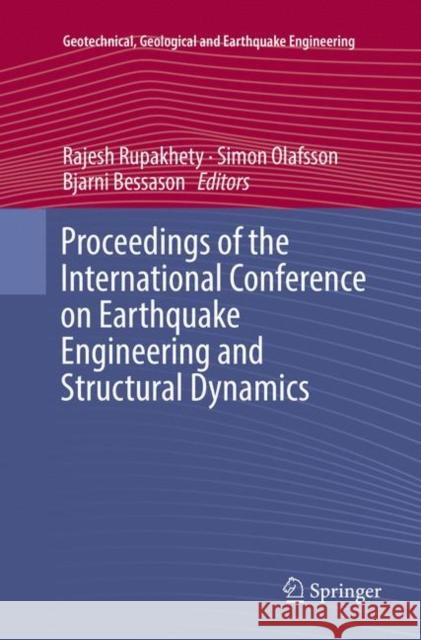Proceedings of the International Conference on Earthquake Engineering and Structural Dynamics » książka



Proceedings of the International Conference on Earthquake Engineering and Structural Dynamics
ISBN-13: 9783030086367 / Angielski / Miękka / 2019 / 510 str.
Proceedings of the International Conference on Earthquake Engineering and Structural Dynamics
ISBN-13: 9783030086367 / Angielski / Miękka / 2019 / 510 str.
(netto: 768,56 VAT: 5%)
Najniższa cena z 30 dni: 771,08 zł
ok. 22 dni roboczych
Bez gwarancji dostawy przed świętami
Darmowa dostawa!
1. Seismic Capacity Reduction Factors for a RC Beam and two RC Columns
2. Characterization of the wave field around an existing end-supported pontoon bridge from simulated data
3. Prediction the Seismic Demands of Tall Buildings Using An Adaptive Force-based Multi-mode Pushover Analysis4. Ambient vibration testing of a 3-storey substandard RC building at different levels of structural seismic damage5. Identification of Rational Functions with a forced vibration technique using random motion histories.6. Seismic Design Procedure for Staggered Steel Plate Shear Wall7. Single-Degree-of-Freedom Analytical Predictive Models for Lead-Core Bearing Devices8. Floor spectra for analysis of acceleration-sensitive equipment in buildings9. Finite element model updating of a long span suspension bridge10. Cyclic capacity of dowel connections11. Experimental Study of New Angle Steel Buckling Restrained Braced Restrained12. The Ranges of Uncertainty among the Use of NGA-West1 and NGA-West 2 Ground Motion Prediction Equations13. Ductile Knee-Braced Frames for Seismic Applications14. Awareness on Seismic Risk: How can Augmented Reality help?15. Seismic Rehabilitation of Masonry Heritage Structures with Base-Isolation and FRP Laminates – A Case Study Comparison16. The Evaluation of Nonlinear Seismic Demands of RC Shear Wall Buildings using a Modified Response Spectrum Analysis Procedure17. Application of MASW in the South Iceland Seismic Zone18. Seismic Fragility Assessment of Reinforced Concrete High-rise Buildings using the Uncoupled Modal Response History Analysis (UMRHA)19. Seismic Response Control of Isolated Bridges Including Soil-Structure Interaction20. Damage observations following the Mw 7.8 2016 Kaikoura earthquake21. Performance of base isolated bridges in recent South Iceland earthquakes22. How to survive earthquakes: the example of Norcia23. System Identification of a Residential Building in Kathmandu Using Aftershocks of 2015 Gorkha Earthquake and Triggered Noise Data24. From seismic input to damage scenario: an example for the pilot area of Mt. Etna volcano (Italy) in KnowRISK Project25. Shaping favorable beliefs to seismic protection through risk communication: A pilot-experience in two Lisbon (Portugal) schools26. Between Perception and Knowledge: the construction of the Italian questionnaire to assess the KnowRISK Project actions27. New Design Spectral Acceleration of Soft and Deep Deposits in Bangkok28. The participatory risk communication action of the KnowRISK project: Italy29. Systematic methodology for planning and evaluation of a multi-source geohazard monitoring system. Application of a reusable template.30. Development of a common (European) tool to assess earthquake risk communication31. KnowRISK on Seismic Risk Communication: the set-up of a participatory strategy32. The dynamic intelligent bridge: A new concept in bridge dynamics33. Seismic risk communication: how to assess it? The case of Lisbon pilot-area. 34. On the manifestation of ground motion model differences on seismic hazard in North Iceland35. Bayesian Heirarchial model of peak ground acceleration for the Icelandic strong-motion arrarys36. Towards an automated Kappa measurement procedure37. Monitoring and Damage Detection of a 70-year-old Suspension Bridge -Ölfusá Bridge in Selfoss, Case Study38. Seismic performance of non-structural elements assessed through shake table tests: The KnowRISK room set-up39. KnowRISK Practical Guide for mitigation of seismic risk due to non-structural components40. A study of rigid blocks rocking against rigid walls
This book includes a collection of chapters that were presented at the International Conference on Earthquake Engineering and Structural Dynamics (ICESD), held in Reykjavik, Iceland between 12-14 June 2017. The contributions address a wide spectrum of subjects related to wind engineering, earthquake engineering, and structural dynamics. Dynamic behavior of ultra long span bridges that are discussed in this volume represent one of the most challenging and ambitious contemporary engineering projects. Concepts, principles, and applications of earthquake engineering are presented in chapters addressing various aspects such as ground motion modelling, hazard analysis, structural analysis and identification, design and detailing of structures, risk due to non-structural components, and risk communication and mitigation.
1997-2025 DolnySlask.com Agencja Internetowa
KrainaKsiazek.PL - Księgarnia Internetowa









